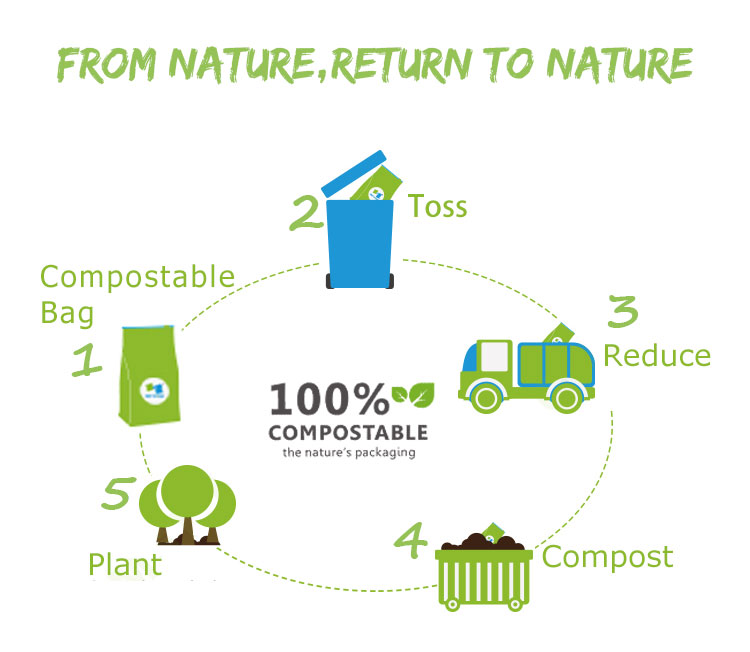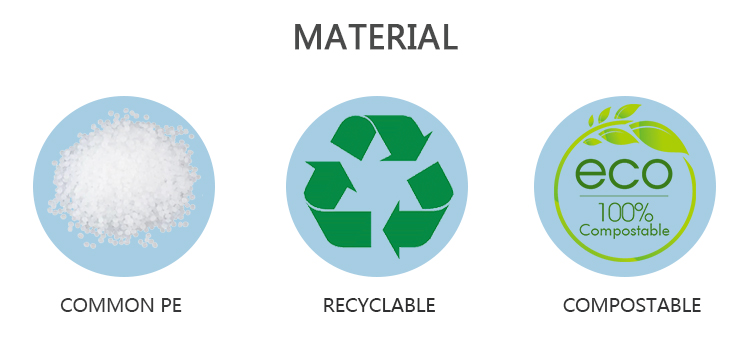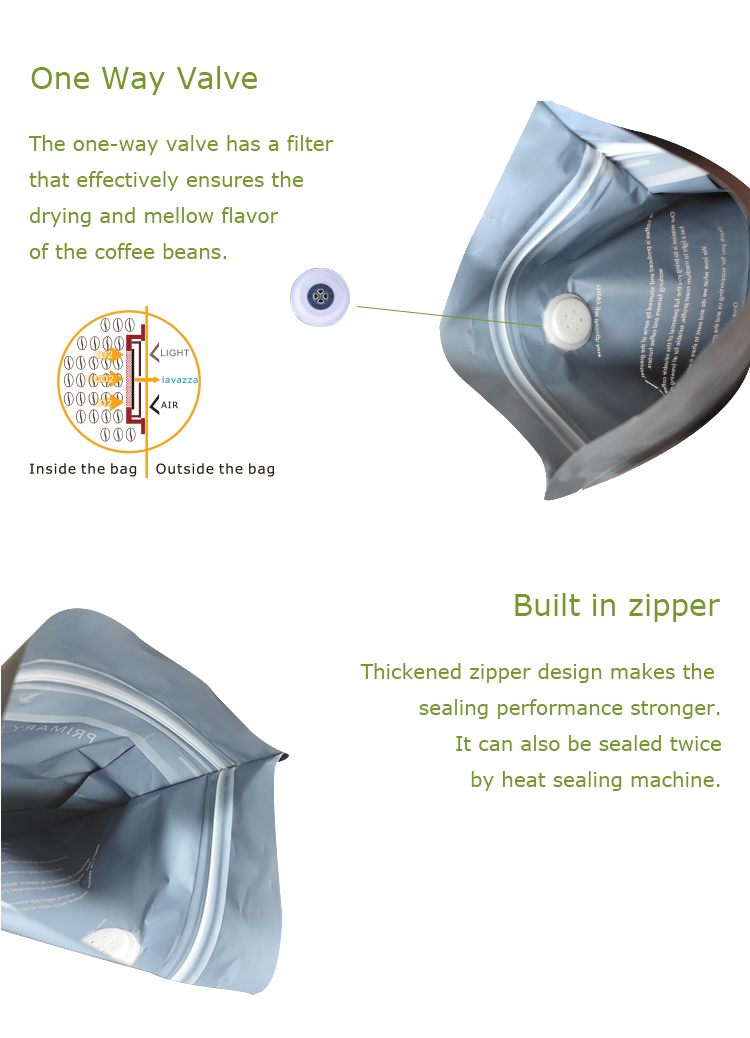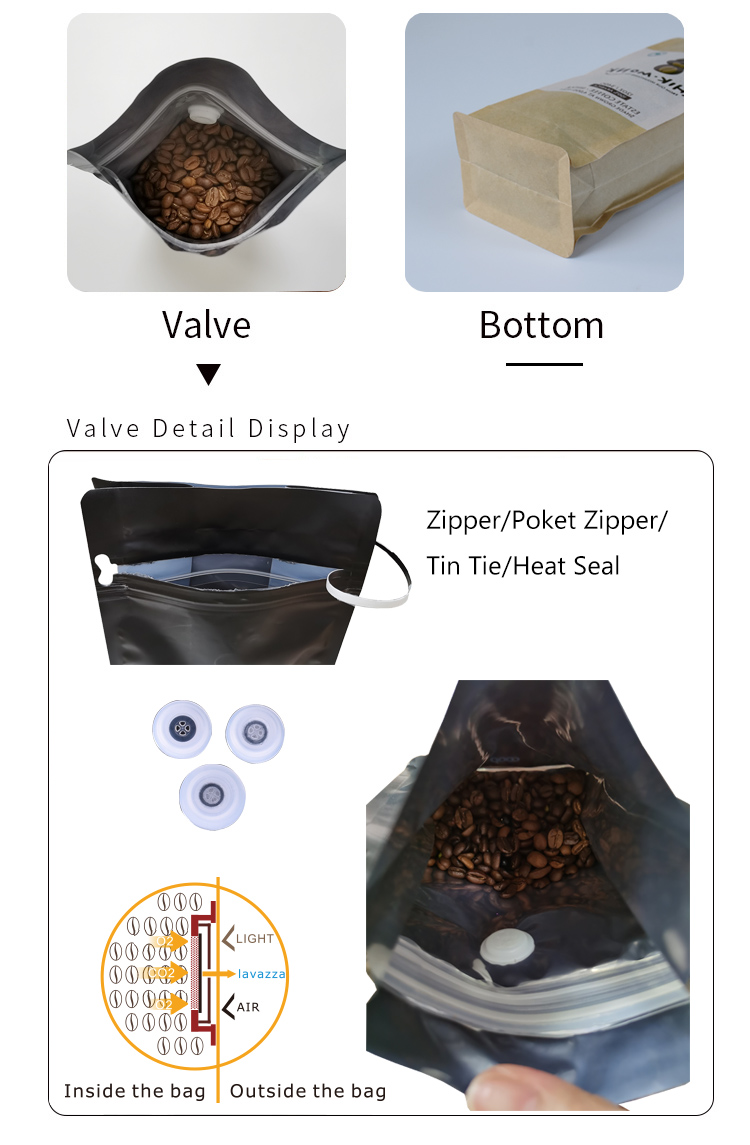- English
- Sales & Support:+86-15015013003
| Place of Origin: | China |
| Brand Name: | MSTPACK |
| Certification: | BPI Certificate, BRC, DIN, ABA |
| Model Number: | PCB040 |
| Minimum Order Quantity: | 10000 |
|---|---|
| Price: | US$ 0.02-0.55 / pcs |
| Packaging Details: | Carton |
| Delivery Time: | 10-15days |
| Payment Terms: | L/C, T/T, Western Union |
| Supply Ability: | 100000 tons/year |
| MATERIAL: | Kraft Paper / PE | COLOR: | Up to 10 colors |
|---|---|---|---|
| SIZE: | Customized | SURFACE HANDLE: | Digital Printing |
| FREE SAMPLES: | Available | TYPE: | Quad Seal Bag |
| USAGE: | Coffee, Tea, Snack, Chocolate, Cookie, Candy, Nuts, Other Food | SEAL & HANDELING: | Heat Seal |
| PORT OF SHIPPING: | Jiangmen | FAST DELIVERY: | 7-10 Work Days |
| HIGH LIGHT: | Biodegradable Coffee Bags | ||
Biodegradable coffee bags are a sustainable alternative to traditional coffee bags, designed with the principle of biodegradability in mind. These eco-friendly coffee bags are typically made from biodegradable materials such as plant-based polymers (e.g., cornstarch-based plastics), paper, or other organic compounds.  Here's how they fit into the concept of biodegradability:
Here's how they fit into the concept of biodegradability:
Biodegradable Coffee Bags Natural Decomposition: Biodegradable coffee bags can naturally decompose over time when discarded. Unlike traditional coffee bags made of non-biodegradable materials like plastic and aluminum foil, biodegradable coffee bags break down into simpler, environmentally benign components. This natural decomposition process reduces their environmental impact.
Biodegradable Coffee Bags Reduced Environmental Footprint: By using biodegradable materials in coffee bag production, the coffee industry can significantly reduce its environmental footprint. These bags break down into non-harmful substances, minimizing the waste sent to landfills and lowering the risk of polluting ecosystems.
Biodegradable Coffee Bags Renewable Resources: Many biodegradable coffee bags are crafted from renewable resources, such as corn or sugarcane. This means that the materials used in these bags can be replenished, reducing dependence on finite resources and decreasing the environmental strain associated with resource extraction.
Biodegradable Coffee Bags Consumer Appeal: In a world increasingly concerned about environmental issues, biodegradable coffee bags hold strong appeal for eco-conscious consumers. Businesses that adopt biodegradable packaging demonstrate their commitment to sustainability, which can attract and retain customers who prioritize eco-friendly choices.
Exposure to Natural Environment: Biodegradable coffee bags must be exposed to the natural environment to initiate the degradation process. This means they need to come into contact with soil, water, or other natural elements.
Microbial Activity: Microbes such as bacteria and fungi are key to degradation. These microorganisms break down the materials of the coffee bags into simpler compounds by secreting enzymes. During degradation, these microbes metabolize organic materials.
Moisture and Oxygen: Moisture and oxygen are also critical factors. They provide the necessary conditions to sustain microbial life and activity. Moisture dissolves degradation by-products, making them easier to disperse into the soil.
Time and Temperature: The rate of degradation depends on time and temperature. In warm and humid environments, degradation typically occurs more rapidly. However, in dry or cold conditions, the process may be slower.
Material of the Coffee Bag: The degradation rate and effectiveness of biodegradable coffee bags depend on the materials used. Common biodegradable materials include starch-based plastics, paper, polylactic acid (PLA), among others. Different materials may exhibit varying rates and modes of degradation.
Environmental Conditions: Soil type, humidity, oxygen levels, and temperature are environmental factors influencing degradation. Organic-rich soils are typically more conducive to degradation.
Degradation Duration: The thickness and structure of coffee bags affect how long they take to degrade. Thinner bags usually degrade faster, while multi-layered bags may take longer.
Microbial Activity: The type and quantity of microbes in the soil also influence degradation. Some soils may have more suitable microbes for breaking down specific materials.
Composting Conditions: If coffee bags are introduced into a composting system, composting conditions play a significant role in the degradation process. Composting systems provide ideal humidity, temperature, and oxygen levels to accelerate degradation.
In summary, biodegradable coffee bags exemplify the concept of biodegradability in practical application. They serve as a responsible and eco-friendly packaging option for coffee products, minimizing waste, reducing environmental impact, and aligning with the principles of sustainability. By choosing biodegradable coffee bags, both coffee producers and consumers can contribute to a greener and more sustainable future.

Biodegradable coffee ties and seals are essential components of eco-friendly coffee packaging, designed not only to preserve the freshness of coffee but also to minimize the environmental impact of the coffee industry. The choice of materials for these accessories is crucial in achieving both these goals. Here, we will explore the various materials that are commonly used for crafting biodegradable coffee ties and seals:
Biodegradable Coffee Bags Jute Twine: Jute is a long, soft, and shiny natural fiber derived from the jute plant (Corchorus olitorius and Corchorus capsularis). It's one of the most commonly used materials for biodegradable coffee ties and seals. Jute is a highly sustainable resource as it grows quickly, requires minimal synthetic pesticides or fertilizers, and can thrive in various climates.
Biodegradable Coffee Bags Cotton Twine: Cotton is another natural fiber used for biodegradable ties. Organic cotton, in particular, is an eco-friendly choice because it's grown without the use of synthetic pesticides or genetically modified organisms (GMOs). Cotton twine is soft, strong, and biodegradable.
Biodegradable Coffee Bags Recycled Paper: Many biodegradable coffee seals are crafted from recycled paper materials. These papers are sourced from post-consumer or post-industrial waste, reducing the demand for virgin pulp and conserving trees.
Biodegradable Coffee Bags Unbleached Paper: Unbleached paper is preferred for biodegradable seals as it avoids the use of chlorine-based bleaching agents, which can be harmful to the environment. Unbleached paper maintains its natural color and is often a better choice for eco-conscious consumers.
Biodegradable Coffee Bags Hemp Fiber:Hemp is an exceptionally sustainable material choice for biodegradable coffee ties and seals. Hemp plants require minimal water, synthetic pesticides, or herbicides, and they grow rapidly. Hemp fibers are strong, durable, and naturally biodegradable, making them an eco-friendly option.
Biodegradable Coffee Bags Cornstarch-Based Materials:Biodegradable Plastics (PLA): Some coffee ties and seals are made from biodegradable plastics, specifically polylactic acid (PLA), which is derived from renewable resources such as cornstarch or sugarcane. PLA is compostable under industrial composting conditions.
Biodegradable Coffee Bags Adhesives:Plant-Based Adhesives: The adhesives used in paper-based seals are typically eco-friendly, often derived from plant-based sources. These adhesives break down naturally and do not introduce harmful chemicals into the environment.
Benefits of Biodegradable Coffee Bags Materials:Sustainability: All the materials mentioned above are renewable resources, which means they can be grown or produced repeatedly, reducing dependence on finite resources.
Biodegradability: These materials naturally break down over time when exposed to environmental conditions, leaving no harmful residues behind.
Reduced Environmental Impact: Choosing these materials over traditional plastics minimizes the environmental burden associated with plastic waste, particularly in terms of plastic pollution in landfills and oceans.
Biodegradable Coffee Bags Labels:
Paper Labels: Biodegradable paper labels are often made from unbleached or recycled paper. Unbleached paper is preferred because it avoids the use of chlorine-based chemicals in the bleaching process, which can be harmful to the environment. These labels are printed with eco-friendly, water-based inks, minimizing the environmental impact of the printing process.
Biodegradable Coffee Bags Filters:

Unbleached Paper Filters: Unbleached paper coffee filters are made from biodegradable paper materials. They are free from chlorine-based bleaching agents, which can harm aquatic ecosystems. Unbleached paper filters are designed to break down naturally, leaving no harmful residues in the environment.
Biodegradable Coffee Bags Hemp Filters:
Hemp coffee filters are gaining popularity among environmentally conscious coffee enthusiasts. Hemp is a renewable resource that requires minimal pesticides and synthetic fertilizers. Hemp filters are biodegradable and provide an eco-friendly alternative to paper.
Biodegradable Coffee Bags Pods:
Plant-Based Plastics: Biodegradable coffee pods are often crafted from plant-based plastics like polylactic acid (PLA). PLA is derived from renewable resources such as cornstarch or sugarcane. These materials are biodegradable, breaking down into non-toxic components when exposed to the right conditions, such as heat and moisture.
Biodegradable Coffee Bags Paper Pods:
Some coffee pods are made entirely from biodegradable paper materials, which are both renewable and compostable. These paper pods are an excellent option for single-serve coffee without the environmental concerns associated with traditional plastic pods.
Biodegradable Coffee Bags Stirrers and Spoons:
Wooden Stirrers and Spoons: Wooden coffee stirrers and spoons are often made from sustainably sourced birchwood or bamboo. These materials are biodegradable and can be composted after use. They provide a natural and eco-friendly choice for stirring coffee.
Compostable Coffee Bags :
Compostable Materials: Compostable coffee packaging accessories, such as bag closures or clips, are typically made from compostable polymers like PLA. These materials break down into nutrient-rich compost when exposed to the right composting conditions, contributing to soil enrichment rather than landfill waste.
By carefully selecting these biodegradable coffee packaging accessories and ensuring they are disposed of properly (e.g., in compost bins), both coffee producers and consumers can actively participate in reducing the environmental impact of coffee consumption. These choices align with the principles of sustainability and contribute to a greener and more responsible coffee industry.
Address: Rm603. Yuanyang Building, No. 1008 of Heshan Avenue, Shaping, Jiangmen, Guangdong, China. Compostable coffee bags, biodegradable coffee bags, resealable coffee bags are made by coffee bags factory China